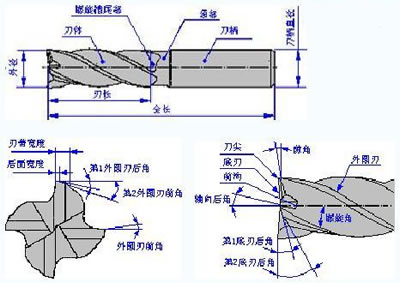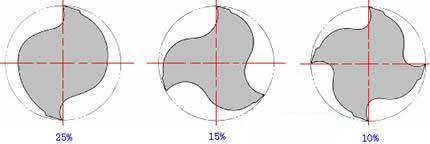"Shaping and writing" teach you to know the end mill
By knowing the names and the number of edges of the end mills, you can better use the tool to program, avoiding the phenomenon of overcutting or knives caused by improper tool selection.
1. The name of each part of the end mill
The names of the various parts of the end mill are shown in Figure 1.

Figure 1 Name of each part of the end mill
2. The number of teeth of the end mill and the cross-sectional area of ​​the chip flute
The ratio of the number of teeth of the end mill to the cross-sectional area of ​​the chip flute is shown in Figure 2.

Figure 2 The number of teeth of the end mill and the cross-sectional area of ​​the chip flute
Table 1 shows the characteristics of the number of teeth and the chip flute

3. Type and shape of end mill
The types and shapes of end mills can be classified according to the outer edge, the bottom edge, the handle and the neck. Different types have different shape characteristics and different positions are processed.
(1) Type, shape and characteristics of the peripheral blade
The types, shapes and characteristics of the peripheral blades are shown in Table 2.
Table 2 Types, shapes and characteristics of peripheral blades

(2) Type, shape and characteristics of the bottom edge
The types, shapes and characteristics of the bottom edge are shown in Table 3.
Table 3 Type, shape and characteristics of the bottom edge

(3) The type, shape and characteristics of the handle and neck
The types, shapes and characteristics of the handle and neck are shown in Table 4.
Table 4 Types, shapes and characteristics of the handle and neck

Wood is divided into two distinct kinds called hardwood and softwood, though confusingly the names don't always refer to its actual hardness or softness:
Hardwoods typically come from broad-leaved (deciduous) trees (those that drop their leaves each fall, also known as angiosperms because their seeds are encased in fruits or pods). Examples include ash, beech, birch, mahogany, maple, oak, teak, and walnut.
Softwoods typically come from evergreen (coniferous) trees (those that have needles and cones and retain them year-round, also called gymnosperms. Examples include cedar, cypress, fir, pine, spruce, and redwood.
KelaiWood , https://www.kelaiwooden.com